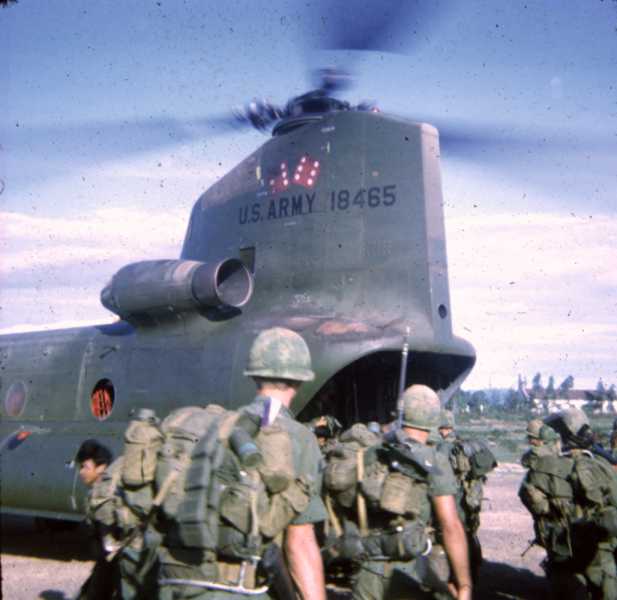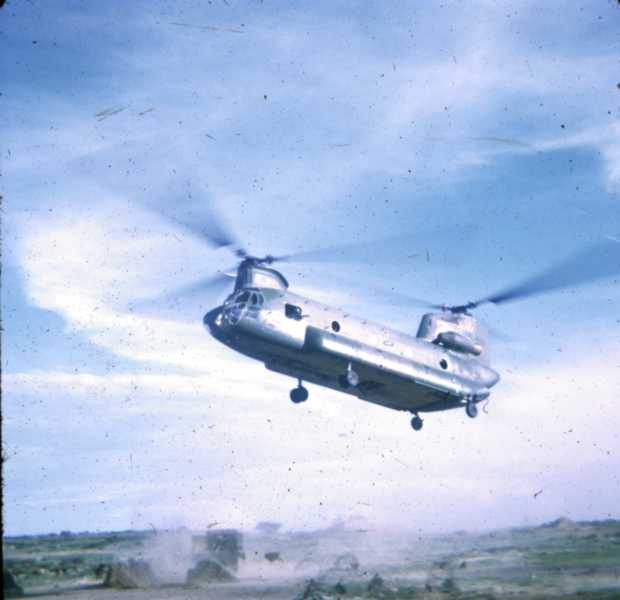View of the Boxcars home between revetments at Chu Lai base. Rocket Ridge is in the distance.
1971 photo from Ray Mendez (3/B/1-6 Inf 1970-71).
The CH-47B Chinook helicopter was a twin-engine, tandem rotor, medium
transport helicopter
with fixed four-wheel landing gear. It had a normal crew of three,
with a crew chief. A cargo
winch had a 3,000 lb. capacity. The rear loading ramp permitted
straight-in loading and a sealed
hull gave the aircraft an emergency water landing capability.
It could carry 33 combat-equipped
troops at 110 knots cruising speed. The external sling capacity
was 16,000 lbs. With a flight
endurance of 2 hrs 40 min, the aircraft could move over 15,000 lbs.
in a 50 nautical mile radius.
Soldiers in the 1st Battalion 6th Infantry sometimes were moved by these
large CH-47 aircraft
between firebases and from field locations back to a firebase or to
Chu Lai. Only rarely were these
aircraft used to move troops to the field when the security of an LZ
could be questionable.
View of the Boxcars home between revetments at Chu Lai base.
Rocket Ridge is in the distance.
1971 photo from Ray Mendez (3/B/1-6 Inf 1970-71).
On 26 Aug 70, 22 soldiers (from D Co. 2nd Bn 1st Inf, 196th Inf Bde)
and the crew of 4 (from
178th ASHC) were killed when bursts of AK-47 rifle fire struck
the unfortunate Boxcar aircraft
as it was on a final approach into LZ Judy, far to the northwest of
Chu Lai. Only one soldier survived
the crash. Thereafter, commanders were understandably reluctant
to use the CH-47s to move troops
when the PZ or LZ could be covered by the VC. Some pilots loved
the aircraft--others swore that
it was inherently unsafe and that they would never ride in one whether
or not they were at the controls.
Three photos provided by Ray Tyndall (3/B/1-6 Inf 70-71).

Soldiers from B Co, 1st Bn 6th Inf, load onto a CH-47 helicopter from
the 178th ASHC at LZ Dottie
preparing to move to Hill 43 (east of LZ Dottie) in September 1970.
Note the gear strapped on the
rucksack (keeping in mind that this is only what is visible in this
photograph on the outside of the pack):
4 canteens; two bandoleers of M-16 ammunition (14 magazines);
1 box M-60 ammo; one clamor
bag; one smoke grenade; and, one poncho. Additional items inside
the rucksack probably include an
additional bandoleer of M-16 ammo in clips rather than magazines; more
ammo in a box for the M-60;
trip flares; and, hand pop illumination flares. When fully loaded
with ammunition, food, and water, the
rucksack could easily weigh sixty or seventy pounds.
[Note: this CH47B Boeing Serial No. 67-18465, Boeing Mfg #B-435
survived the war and was
remanufactured into a "D" Model 88-00090.]
Soldiers from B Co. 1st Bn 6th Infantry unload at Hill 43 (BS 685 917)
from CH-47 helicopters from
the 178th Assault Support Helicopter Company (Boxcars). Note
the double six dice painted on the aft
of the aircraft.

A CH47 Chinook helicopter drops off a load at an LZ in 1970.
The rotor wash produced tremendous
winds on the LZ/PZ that could knock a man down if he stood upright
without bracing himself. A small
LZ/PZ sometimes was left in shambles as boxes, tents, etc. were blown
away when the aircraft departed.
Door gunner keeps a watchful eye from a 178th ASHC "Boxcar" - photo
from Bob Leahy
View looking back over the ramp of a CH47 Chinook while several thousand
feet high over Chu Lai.
This view looks southward to the 1st Bn 6th Inf area of operations
in 1970-71. Photo provided by
Al Simms.
The view straight down from the cargo winch of a CH-47 Chinook helicopter.
Watch where
you step! See CH-47 interior at this
link. (The hedge rows visible on the ground provide good
concealment for trenches and bunkers. Helicopters are interesting,
but the stuff on the ground
could kill you!) Photo from Ray Mendez (3/B/1-6 Inf 1970-71)
Select additional photos from the index at left, or link to the 1st Battalion 6th Infantry Home Page